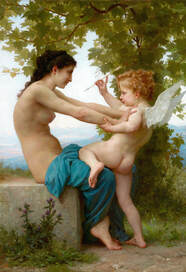NFTs

William-Adolphe Bouguereau is very possibly my favorite artist of all time. You’ve no doubt seen his work when strolling through the isle looking for a Valentine’s Day card. You may have seen it in advertisements, in movies or even in museums.
Born in 1825, in the latter half of the 19th Century Bouguereau’s work personified art in the eyes of official French society. It was classical, it was allegorical and it was realistic, with captivating images of women, children, angels and occasionally males, including Christ. In the salons of the time his work was the perfect example of what was “acceptable”.
It was at this same time however that the Impressionists were traveling down a different road. In all actuality they had no choice. The Paris salon, which was the premier art show of its time, was administered by the Académie royale de peinture et de sculpture (“Royal Academy of Painting and of Sculpture”) whose jury decided who could exhibit and who could not. And the Impressionists could were not exactly their cup of tea...
Facing blackballing from the official salon, the Impressionists decided to do something rather radical. They created their own “salon” in 1874. Over the next 40 years the artistic tastes of the west would radically shift towards the Impressionists while the work of Bouguereau would fade into something approaching irrelevancy, particularly after his death in 1905. In the world of art this shift was an earthquake.
This Impressionist upheaval opened the floodgates to a new world of art that would evolve in seemingly a million different directions from Duchamp’s Fountain to Picasso’s Guernica, Pollock’s drips, and palettes by Mark Rothko as well as Brillo Boxes by Warhol, sharks in formaldehyde by Damien Hirst and graffiti seemingly everywhere.
Today, with NFT pieces the art universe has taken the upheaval launched by the Impressionists and has catapulted it somehow into a black hole. Not in the sense of down a hole never to be seen again, but rather, down a hole where there the laws of everything seem to get lost. Tangible? Probably not. Evocative? Maybe, maybe not. Visible. Perhaps. Measurable? Not necessarily. Original? Pffftt. Real? Great question.
Elons
Maybe the only thing that can be said for certain about NFTs is that they are trackable. Otherwise there are literally no boundaries as to what can be called art. And it’s into this world of “no boundaries” I’ve jumped with my King of the Universe Space Club collection. It's a collection of 5555 pieces (called Elons) inspired by the irrepressible Elon Musk. The collection is based on things that Musk has done or said in business, culture or somewhere lost in space. Tesla, McDonalds' broken ice cream machines, space travel, flamethrowers, Saturday Night Live just to name a few. And each one is made out of hemp... That's not really true. They were created with Photoshop and Illustrator but there is a 420 clock featured in some. In the end it's all about fun and it would be great if buyers made money from them, especially if they don't win the pallet of Coke or the Tesla I'm giving away!
(Below are some of the Elons, the actual ones are in color!)
Where will this untamed frontier that Satoshi Nakamoto sparked lead? Who knows? I just wonder how much Bouguereau we'll find there...
vince@vincecoynerart.com
vince@vincecoynerart.com





